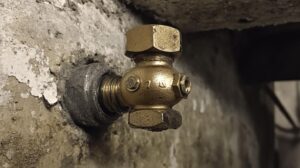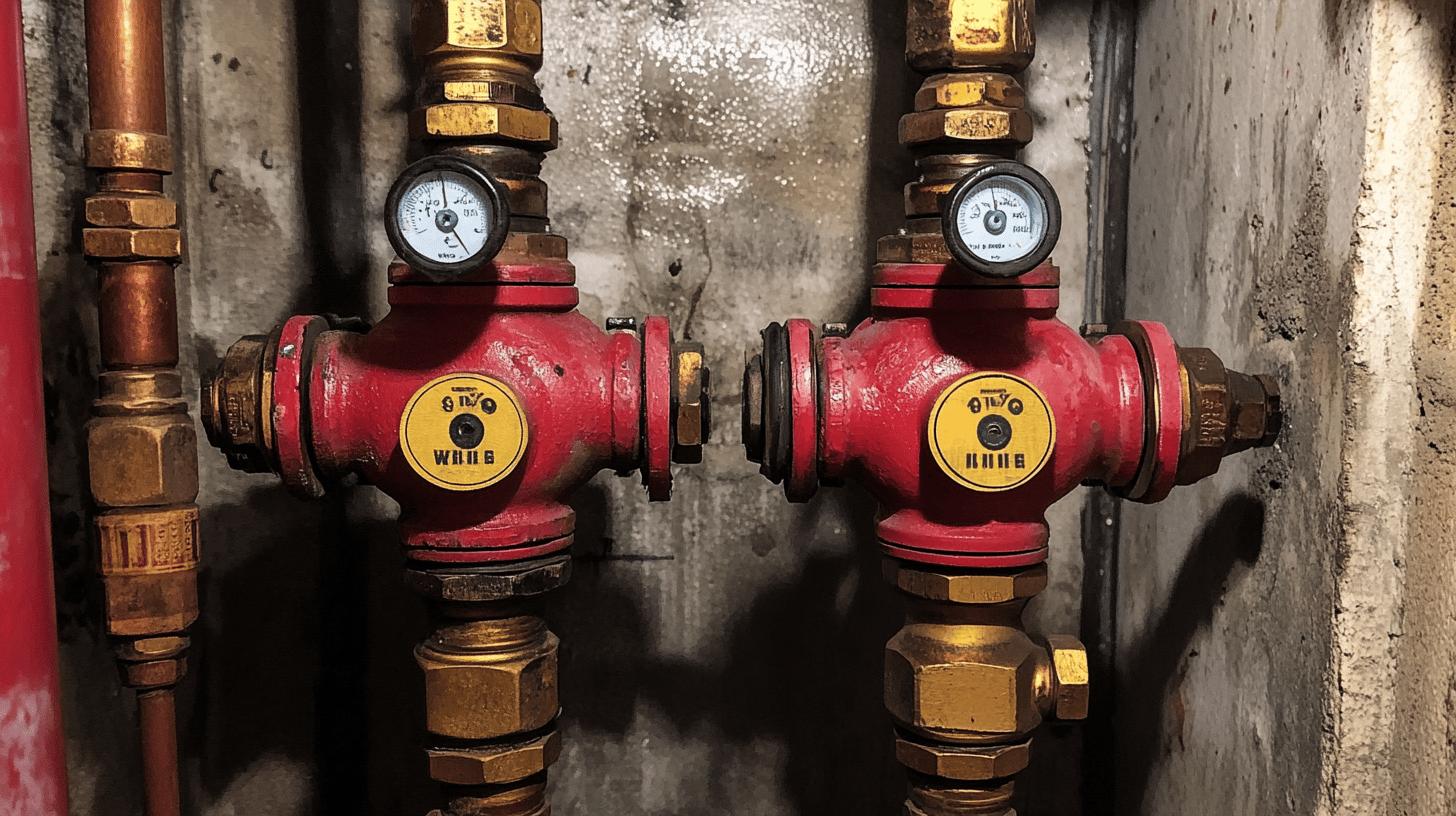TL;DR:
- Gas valves manage gas flow; water valves control water flow.
- Gas valves are typically made from brass, bronze, aluminum, or stainless steel; water valves often use brass and PVC.
- Types of gas shut-off valves: Ball (on/off), Butterfly (space-efficient), Plug (quick shut-off), Needle (precise flow), Check (prevents backflow).
- Water valve types: Gate (main control), Globe (flow regulation), Butterfly (compact design).
- Gas valves are near the gas meter; water valves are by the water meter or main line.
- Safety tips: Use a wrench for gas valves; check for corrosion on water valves.
- Regular maintenance helps prevent failures and leaks.
Ever wondered why your home has both gas and water shut-off valves, and what makes them different? These two valves play important roles in managing your home’s utilities, but they do very different things. Gas valves control gases like natural gas and are made from tough metal, while water valves control the flow of pressurized water in your plumbing system. Knowing the differences helps you understand your home’s maintenance better and lets you act quickly if there’s an emergency.
Understanding Gas vs Water Shut Off Valves
Gas and water shut-off valves are crucial for home maintenance. Gas valves control the flow of gases like natural gas and are essential for safety, allowing you to quickly cut off the gas supply during emergencies or repairs, which helps prevent leaks and hazards. Water shut-off valves, on the other hand, manage the flow of pressurized water, making plumbing repairs or upgrades easier without affecting the entire house’s water supply. Both types are important for controlling systems locally, ensuring safety and convenience.
When it comes to construction, gas valves and water valves differ in materials. Gas valves are made from strong metals like brass, bronze, aluminum, or stainless steel to handle high pressure and resist corrosion. Water valves, while still durable, are typically made from brass or PVC, which are better suited for water pressure needs. These materials are chosen to ensure each valve works well and stays safe over time.
- Gas valves manage gas flow; water valves handle water flow.
- Gas valves often use metals like brass and stainless steel, while water valves might use PVC.
- Gas valves are crucial for safety, isolating gas during emergencies.
- Water valves allow localized shut-off for easy plumbing repairs without disrupting the system.
- Operating gas valves usually needs specific tools, but water valves are often manually easier.
Types of Gas Shut Off Valves
Choosing the right gas shut-off valve is essential for safety and managing gas flow effectively. Different valve types are suited for various needs in residential, commercial, or industrial settings. They’re designed to handle varying pressures and flow rates, making them key for controlling and isolating the gas supply. Picking the right valve helps prevent leaks and ensures smooth operation and maintenance of the gas system.
Gas shut-off valves come in several types, each with its own function. Ball valves use a simple quarter-turn to control the flow, offering reliable on/off control. Butterfly valves, which have a rotating disc, are compact and often preferred for their size. Plug valves use a rotating plug mechanism, making them ideal for quick shut-offs. Needle valves allow for precise flow control and are used when fine adjustments are needed. Check valves prevent backflow by allowing gas to flow in only one direction, maintaining system integrity.
Proper positioning of these valves is crucial. For ball and butterfly valves, the handle is parallel to the pipe when open and perpendicular when closed, making it easy to check the valve’s status. Plug valves work similarly. Needle valves require careful adjustments because of their precision. Check valves, which work automatically, must be installed with the correct flow direction.
| Valve Type | Use |
|—————–|——————————————|
| Ball Valve | Reliable on/off control for general use |
| Butterfly Valve | Compact for large flow systems |
| Plug Valve | Quick shut-off in high-pressure areas |
| Needle Valve | Precise flow regulation |
| Check Valve | Prevents backflow |
Types of Water Shut Off Valves
Gate, globe, and butterfly valves are common in plumbing, each with specific uses. Gate valves are designed for fully opening or closing the flow, making them ideal for shutting off the main water supply or controlling large branch lines. Globe valves are used to regulate or throttle water flow, perfect for precise control like on outdoor faucets. Butterfly valves are compact and useful when you need to adjust flow without fully shutting it off.
These valves operate differently. Gate valves use a gate that lifts to control the flow, with a twist lever for full on/off control, allowing minimal pressure drop and full flow. Globe valves have a stopper that moves along a stem, enabling precise flow regulation with a twist of the knob. Butterfly valves use a rotating disc to adjust flow quickly, though they may require more maintenance over time.
Positioning these valves correctly is important for proper operation. Gate valves should be either fully open or closed to prevent damage. Globe valves allow partial opening for flow control, but excessive throttling should be avoided to prevent wear. Butterfly valves should be positioned with the lever parallel when open and perpendicular when closed for correct status.
- Gate valves suit main water line control.
- Globe valves offer precise flow regulation.
- Butterfly valves are space-efficient and quick to operate.
- Design minimizes pressure drop, optimizing performance.
- Correct positioning ensures efficiency and less maintenance.
Locating Gas and Water Shut Off Valves in Your Home
Gas shut-off valves are important for controlling the gas supply safely during emergencies or repairs. They’re typically located inside, where the gas line enters the home, often near the gas meter in a utility room, basement, or garage. In older homes, they might be found outside. Knowing where your gas valve is can help you act quickly to prevent leaks or hazards.
Water shut-off valves control the water supply in your home, making them essential for repairs or emergencies. They’re usually located near the water meter or main water line. In colder climates, they’re typically indoors, like in basements, to avoid freezing. In warmer areas, they may be outside in a covered box. Knowing where these valves are located can save you time and reduce damage during emergencies.
- Look near the gas meter or house entry for gas valves.
- Check near the meter or water line entry for water valves.
- Gas valves have lever handles, usually needing a wrench.
- Water valves typically have twist knobs for manual use.
Safety Tips for Operating Shut Off Valves
Operating gas valves safely is crucial to prevent leaks or explosions. Always have a special wrench on hand. Make sure the area is well-ventilated before turning off the valve to avoid gas buildup. Use gentle force when operating the valve to prevent damage. If you suspect a gas leak, don’t attempt to shut it off—evacuate immediately and contact the gas company or emergency services.
Water valves are simpler to use but still require care. You may need to turn them multiple times to fully close. Check for signs of corrosion or wear to avoid leaks. Turning them on and off regularly helps prevent them from sticking. If they’re difficult to turn, it’s best to call a professional plumber to avoid causing damage.
- Keep a gas valve wrench handy.
- Ensure good ventilation when using gas valves.
- Turn water valves slowly.
- Regularly check for corrosion or wear.
- Move valves periodically to prevent sticking.
- Seek professional help with valve issues.
Maintenance and Troubleshooting for Shut Off Valves

Maintaining shut-off valves is key to avoiding failures and ensuring they work properly. Both gas and water valves can wear down over time due to constant use and exposure to the elements. Without regular maintenance, they might leak or become difficult to turn, leading to safety or water damage risks. Checking them regularly helps spot corrosion or mechanical problems early, allowing for quick fixes.
For gas valves, start by checking for leaks or blockages. If the valve’s hard to turn, it might have debris or a worn seal. Look for signs like hissing sounds or a gas smell. If it’s stuck, gently turn the valve with a wrench, but don’t force it. If the problem persists, call a professional plumber or gas technician for safe handling.
Water valve issues usually include leaks or stiffness. Check for corrosion or mineral buildup. If the valve’s stiff, apply lubricant for plumbing fixtures. For minor leaks, tighten connections. If problems continue, contact a professional plumber to ensure everything’s safe.
Regularly checking and maintaining your valves will help them last longer and prevent unexpected issues or costly repairs.
Final Words
Understanding the difference between gas and water shut-off valves is key for home safety and upkeep. This blog covered their roles, how they’re built, and the types you’ll find in homes. You also learned how to locate them and essential safety tips.
Knowing how these valves work and how to maintain them is crucial for keeping your home running smoothly and safely. By understanding their differences and proper care, you can avoid costly repairs and disruptions.
With this info, you’re now better prepared to deal with any valve issues that may arise. Use these tips to help keep your home safe and efficient.
FAQ
Are gas and water shut-off valves the same?
Gas and water shut-off valves differ in function and construction. Gas valves control the flow of gases like natural gas, using materials such as metal alloys. Water valves manage pressurized water flow, commonly used in plumbing systems.
Will a gas shut-off valve work for water?
A gas shut-off valve is not suitable for water. Each valve is designed specifically for its medium, with gas valves built to handle gas pressures and water valves designed for liquids at various pressures.
Does every house have a gas shut-off valve?
Most homes with gas service have a main shut-off valve. This valve is crucial for quickly stopping the gas flow in emergencies and is usually located where the gas line enters the home.
What type of shut-off valve is best?
The best shut-off valve depends on the application. For gas, ball valves are popular due to their reliability. For water, gate and globe valves are common, each offering unique flow control benefits.
Where should a gas shut-off valve be located?
The main gas shut-off valve is typically found inside the home, near where the gas line enters. Auxiliary shut-off valves may also be located outside the house, near appliances or meters.
Are there different types of gas shut-off valves?
Yes, gas shut-off valves come in various types, such as ball, butterfly, and plug valves. Each type serves specific applications, from simple residential systems to complex industrial setups.
What are old style gas shut-off valves?
Old-style gas shut-off valves often include traditional designs like gate or needle valves, which may not meet modern efficiency or safety standards compared to newer models like ball or butterfly valves.
Are there specific regulations for gas shut-off valves?
Yes, gas shut-off valves must comply with local regulations and standards for safety and performance. These regulations ensure proper material usage and installation to prevent leaks and other hazards.
Where is the main gas shut-off valve in my house?
The main gas shut-off valve is usually located near the point where the gas service line enters the house, often in a basement or utility area for easy access during emergencies.
What should I know about SoCalGas, Atmos Energy, and other companies?
Companies like SoCalGas and Atmos Energy manage gas distribution and supply. Each may have specific guidelines for shut-off valves, so checking with the local provider for detailed regulations is wise.

